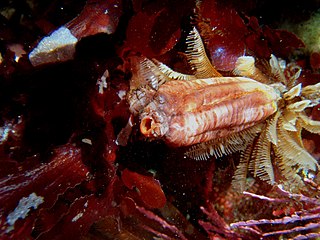
A tunicate is a marine invertebrate animal, a member of the subphylum Tunicata. It is part of the Chordata, a phylum which includes all animals with dorsal nerve cords and notochords. The subphylum was at one time called Urochordata, and the term urochordates is still sometimes used for these animals. They are the only chordates that have lost their myomeric segmentation, with the possible exception of the 'seriation of the gill slits'.

Siphonophorae is an order of Hydrozoans, a class of marine organisms belonging to the phylum Cnidaria. According to the World Register of Marine Species, the order contains 175 species.

Marrus orthocanna is a species of pelagic siphonophore, a colonial animal composed of a complex arrangement of zooids, some of which are polyps and some medusae. It lives in the Arctic and other cold, deep waters, swimming independently in mid-ocean. It is a colonial creature that is born from a single egg which is fertilized. Later on, a protozoan form that eventually grows to form more duplicating members of the colony.

Styela montereyensis, also called the Stalked Tunicate, Monterey stalked tunicate, and the Long-stalked sea squirt is a solitary ascidian tunicate. It has a cylindrical, yellow to dark reddish-brown body and a thin trunk that anchors it to rocks. It is found in subtidal areas of the western coast of North America from Vancouver Island to Baja California.

Serpula vermicularis, known by common names including the calcareous tubeworm, fan worm, plume worm or red tube worm, is a species of segmented marine polychaete worm in the family Serpulidae. It is the type species of the genus Serpula and was first described by Carl Linnaeus in his 1767 12th edition of Systema Naturae. It lives in a tube into which it can retract.

Pyrosoma atlanticum is a pelagic species of marine colonial tunicate in the class Thaliacea found in temperate waters worldwide. The name of the genus comes from the Greek words pyros meaning 'fire' and soma meaning 'body', referring to the bright bioluminescence sometimes emitted. The specific epithet atlanticum refers to the Atlantic Ocean, from where the first specimen of the species was collected for scientific description; it was described in 1804 by François Péron, a French naturalist.
Dolioletta gegenbauri is a species of tunicate in the family Doliolidae. It is small, exists in various forms and is sometimes found in great abundance in the Atlantic and Pacific waters where it lives.

Aplidium californicum is a species of colonial sea squirt, a tunicate in the family Polyclinidae. It is commonly known as sea pork.
Ecteinascidia turbinata, the mangrove tunicate, is a sea squirt species in the genus Ecteinascidia, which was described to science in 1880 by William Abbott Herdman. The cancer drug trabectedin is isolated from E. turbinata.

Atriolum robustum is a colonial tunicate or sea squirt in the family Didemnidae. It is native to the western and central Indo-Pacific where it is usually found anchored to a hard surface in shallow water.

Didemnum molle is a species of colonial tunicate in the family Didemnidae. It is commonly known as the tall urn ascidian, the green barrel sea squirt or the green reef sea-squirt. It is native to the Red Sea and the tropical waters of the Indo-Pacific region.

Didemnum vexillum is a species of colonial tunicate in the family Didemnidae. It is commonly called sea vomit, marine vomit, pancake batter tunicate, or carpet sea squirt. It is thought to be native to Japan, but it has been reported as an invasive species in a number of places in Europe, North America and New Zealand. It is sometimes given the nickname "D. vex" because of the vexing way in which it dominates marine ecosystems when introduced into new locations, however the species epithet vexillum actually derives from the Latin word for flag, and the species was so named because of the way colonies' long tendrils appear to wave in the water like a flag.
Perophora viridis, the honeysuckle tunicate, is a species of colonial sea squirt in the genus Perophora found in the tropical western Atlantic Ocean.

Morchellium argus, the red-flake ascidian, is a species of colonial sea squirt, a tunicate in the family Polyclinidae. It is native to shallow water in the northeastern Atlantic Ocean, especially round the coasts of Britain.

Polyclinum aurantium is a species of colonial sea squirt, a tunicate in the family Polyclinidae. It is native to shallow water in the northeastern Atlantic Ocean and Mediterranean Sea.

Polyclinum planum, is a compound ascidian commonly known as the Elephant Ear Tunicate. It is an ascidian tunicate in the family Polyclinidae. Ascidians are also known as sea squirts.

Cryptosula pallasiana is a species of colonial bryozoan in the order Cheilostomatida. It is native to the Atlantic Ocean where it occurs in northwestern Europe and northern Africa, and the eastern seaboard of North America. It has been accidentally introduced to the western coast of North America and to other parts of the world.

Boltenia villosa is a species of tunicate, a marine invertebrate of the family Pyuridae. Common names include the spiny-headed tunicate, the hairy sea squirt, the stalked hairy sea squirt and the bristly tunicate. This species was first described in 1864 by the American marine biologist William Stimpson who gave it the name Cynthia villosa. It was later transferred to the genus Boltenia. The type locality is Puget Sound, Washington state, United States.

Pyura haustor is a species of sessile ascidian, or sea squirt, that lives in coastal waters in the north-eastern Pacific Ocean, attached to rocks or artificial structures. Common names for this species include the wrinkled seapump, the wrinkled sea squirt and the warty tunicate.

Aplidium elegans (sea-strawberry) is a species of colonial sea squirt, a tunicate that is a benthic invertebrate in the family Polyclinidae and class Ascidiacea. It is native to shallow waters in the Atlantic Ocean and Mediterranean Sea. It is also found in between France and the United Kingdom.

















